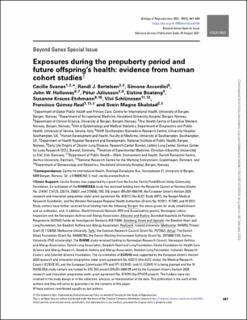| dc.contributor.author | Svanes, Cecilie | |
| dc.contributor.author | Bertelsen, Randi Jacobsen | |
| dc.contributor.author | Accordini, Simone | |
| dc.contributor.author | Holloway, John W. | |
| dc.contributor.author | Juliusson, Pétur Benedikt | |
| dc.contributor.author | Boateng, Eistine | |
| dc.contributor.author | Krauss-Etchmann, Susanne | |
| dc.contributor.author | Schlünssen, Vivi | |
| dc.contributor.author | Real, Francisco Gomez | |
| dc.contributor.author | Skulstad, Svein Magne | |
| dc.date.accessioned | 2022-04-01T11:40:54Z | |
| dc.date.available | 2022-04-01T11:40:54Z | |
| dc.date.created | 2021-11-18T13:04:36Z | |
| dc.date.issued | 2021 | |
| dc.identifier.issn | 0006-3363 | |
| dc.identifier.uri | https://hdl.handle.net/11250/2989271 | |
| dc.description.abstract | Emerging evidence suggests that exposures in prepuberty, particularly in fathers-to-be, may impact the phenotype of future offspring. Analyses of the RHINESSA cohort find that offspring of father’s exposed to tobacco smoking or overweight that started in prepuberty demonstrate poorer respiratory health in terms of more asthma and lower lung function. A role of prepuberty onset smoking for offspring fat mass is suggested in the RHINESSA and ALSPAC cohorts, and historic studies suggest that ancestral nutrition during prepuberty plays a role for grand-offspring’s health and morbidity. Support for causal relationships between ancestral exposures and (grand-)offspring’s health in humans has been enhanced by advancements in statistical analyses that optimize the gain while accounting for the many complexities and deficiencies in human multigeneration data. The biological mechanisms underlying such observations have been explored in experimental models. A role of sperm small RNA in the transmission of paternal exposures to offspring phenotypes has been established, and chemical exposures and overweight have been shown to influence epigenetic programming in germ cells. For example, exposure of adolescent male mice to smoking led to differences in offspring weight and alterations in small RNAs in the spermatozoa of the exposed fathers. It is plausible that male prepuberty may be a time window of particular susceptibility, given the extensive epigenetic reprogramming taking place in the spermatocyte precursors at this age. In conclusion, epidemiological studies in humans, mechanistic research, and biological plausibility, all support the notion that exposures in the prepuberty of males may influence the phenotype of future offspring. | en_US |
| dc.language.iso | eng | en_US |
| dc.publisher | Oxford University Press | en_US |
| dc.rights | Navngivelse 4.0 Internasjonal | * |
| dc.rights.uri | http://creativecommons.org/licenses/by/4.0/deed.no | * |
| dc.title | Exposures during the prepuberty period and future offspring's health: evidence from human cohort studies | en_US |
| dc.type | Journal article | en_US |
| dc.type | Peer reviewed | en_US |
| dc.description.version | publishedVersion | en_US |
| dc.rights.holder | Copyright 2021 the authors | en_US |
| cristin.ispublished | true | |
| cristin.fulltext | original | |
| cristin.qualitycode | 1 | |
| dc.identifier.doi | 10.1093/biolre/ioab158 | |
| dc.identifier.cristin | 1955960 | |
| dc.source.journal | Biology of Reproduction | en_US |
| dc.source.pagenumber | 667-680 | en_US |
| dc.identifier.citation | Biology of Reproduction. 2021, 105 (3), 667-680. | en_US |
| dc.source.volume | 105 | en_US |
| dc.source.issue | 3 | en_US |

